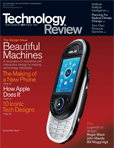|
Wednesday, May 23, 2007 Precision Pointing with Fat FingersContinued from page 1 By Michael Gibson
An experiment conducted by the Microsoft team last summer compared Shift with Offset Cursor and with unassisted touch-screen use. During the study, 12 participants had to point their finger and press on a series of targets as they popped up on the screen. In these trials, the researchers found that Shift outperformed the other methods because it could adapt to different target sizes. "The biggest benefit of Shift is the simplicity of pressing on the target itself," says Daniel Vogel, a PhD candidate at the University of Toronto, who assisted Baudisch on the project. "We found a way to help people without them having to think about doing something different than they would normally do with their finger." In the experiment, the smallest targets Baudisch and Vogel presented were six-by-six pixels. For even smaller tasks, such as pinpoint drawing, the Shift team created a special application that lets users isolate individual pixels by magnifying the area copied in the pop-up window and increasing the sensitivity of the screen to the users' movements. Ultimately, Baudisch believes that Shift could make it easier for users to switch tasks on their mobile devices, without eliminating the stylus altogether. He also hopes to use the same approach to streamline the interactions between phones, notebooks, and wall displays. "In the future, we'll be able to use very small screens to give us overviews of complex information and then quickly delve deeper into it on larger devices when necessary." Baudisch declined to say exactly when Shift will be brought to market. But he is confident it won't be long. |
 |
||||||
|
||||||

 Add to Facebook
Add to Facebook




Comments